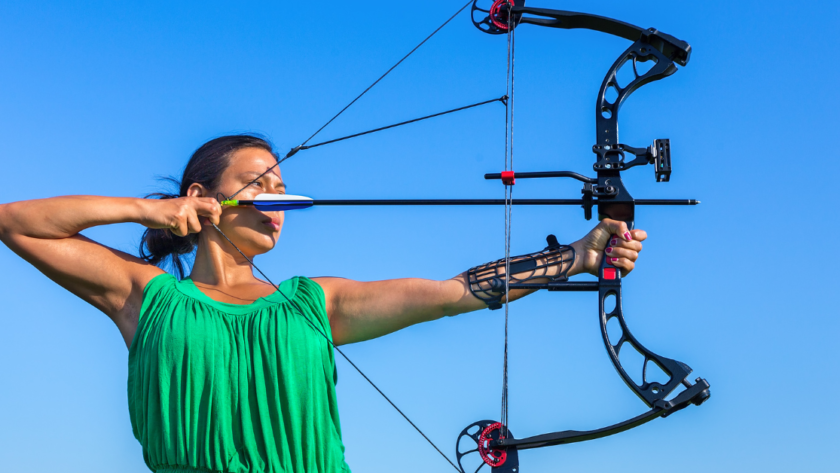Women’s participation in this ancient sport has surged, prompting manufacturers to develop compound bows tailored specifically for female archers. These bows are not mere cosmetic alterations of men’s models – they represent a fundamental shift in design philosophy, embracing the unique physical attributes and biomechanics of women.
The Evolution of Women’s Compound Bows
When compound bows first emerged in the 1960s, they revolutionized archery for all participants. However, it took decades for manufacturers to recognize and address the specific needs of female archers.
Early tries often resulted in smaller, colorful versions of men’s bows that failed to account for the biomechanical differences between male and female archers.
Today’s women’s compound bows are sophisticated pieces of engineering. They are purpose-built tools designed to complement the female form and shooting style, offering improved performance, comfort, and accuracy.
Key Features of Women’s Compound Bows
Shorter Axle-to-Axle Length
Most women’s compound bows range from 28 to 33 inches in axle-to-axle length, compared to men’s bows that can exceed 35 inches. This shorter length enhances maneuverability and reduces the risk of string contact with clothing or body parts.
The compact design works in harmony with a woman’s typically shorter torso, allowing for a more natural and comfortable shooting position.
Adjustable Draw Weight
Women’s bows often feature a wide range of adjustable draw weights, starting as low as 10 pounds and increasing up to 70 pounds. This extensive range accommodates archers of varying strength levels and allows for gradual progression as the archer develops her skills and muscular strength over time.
Shorter Draw Length
The average draw length for women’s bows typically falls between 24 and 28 inches, accommodating the generally shorter arm spans of female archers. This feature confirms that women can achieve proper form and full draw without overextending or straining.
Higher Let-Off
Many women’s bows boast let-off percentages of 75-85%. This high let-off reduces the amount of weight held at full draw, making it easier to maintain aim for extended periods.
This feature is particularly beneficial for target shooting and hunting scenarios where patience and precision are crucial.
Ergonomic Grip
Women’s compound bows often feature narrower, more ergonomic grips designed to fit smaller hands comfortably. This improved fit reduces hand torque and promotes a more consistent and accurate shot.
The Biomechanics Behind Women’s Compound Bows
Understanding the biomechanics of archery is crucial for appreciating the importance of women-specific bow designs. A 2017 study published in the Journal of Sports Sciences revealed that female archers exhibit different muscle activation patterns compared to their male counterparts.
These differences extend beyond mere strength variations and involve how the body moves and distributes force during the archery process.
Women typically have a lower center of gravity, different shoulder-to-hip ratios, and varying muscle distribution compared to men. These physiological differences influence everything from stance to draw technique.
A bow designed with these factors in mind can significantly improve performance and reduce the risk of injury.
For example, the shorter axle-to-axle length of women’s bows creates a more compact system that works harmoniously with a woman’s body structure. This design allows for a more natural and comfortable shooting position, reducing strain and improving overall form.
The Psychological Edge of Proper Equipment
The mental aspect of archery is equally important as the physical technique. Feeling confident and comfortable with your equipment plays a crucial role in an archer’s performance and enjoyment of the sport.
When an archer uses a bow designed for someone else’s body type, it can lead to frustration, decreased motivation, and even abandonment of the sport.
A well-fitted women’s compound bow provides a significant psychological boost. The feeling of using equipment specifically designed for your body type can instill a sense of belonging and competence in the sport.
This confidence often translates directly into improved performance and a more enjoyable archery experience.
Customization: The Key to Perfect Fit
One of the most significant advantages of modern women’s compound bows is their high degree of adjustability. Many models offer a wide range of draw weight and draw length adjustments, allowing archers to fine-tune their bows as they develop their skills and strength.
This adaptability serves several important purposes:
- It allows beginners to start with a comfortable setup and gradually increase difficulty as they improve.
- It accommodates changes in strength and technique over time without the need to purchase a new bow.
- It enables the bow to be shared among family members or friends of different sizes.
When selecting a compound bow, look for models with easy-to-adjust modules that don’t require a bow press. This feature allows you to make changes on your own, saving time and money on trips to the pro shop.
Common Pitfalls to Avoid
While women’s compound bows offer many advantages, there are some common mistakes to watch out for:
Choosing Based on Aesthetics Alone
Flashy colors or designs can be appealing, but they should never take precedence over proper fit and functionality. Focus on finding a bow that fits your body and shooting style first, then consider aesthetics as a secondary factor.
Overestimating Initial Draw Weight
Many new archers, eager to prove their strength, choose a draw weight that’s too heavy for them to handle comfortably. Starting with a lower draw weight allows you to focus on developing proper form and technique without struggling against the bow.
You can always increase the draw weight as you build strength and skill.
Ignoring Proper Form
A well-fitted bow is only part of the equation for successful archery. Invest time in learning and practicing proper shooting technique.
Consider taking lessons from a qualified instructor to establish a solid foundation of fix form.
Neglecting Maintenance
Regular maintenance is crucial for keeping your bow in top condition. Learn basic upkeep procedures such as waxing the string, checking for loose screws, and inspecting the cables.
For more complex maintenance, establish a relationship with a reliable bow technician.
Rushing the Selection Process
Choosing the right bow takes time and patience. Try many models, ask questions, and don’t feel pressured to make an immediate decision.
Many pro shops offer test shooting sessions – take advantage of these opportunities to find the bow that feels most comfortable and natural for you.
Adapting to Different Archery Disciplines
Whether you’re interested in target archery, 3D archery, or bowhunting, there’s a women’s compound bow that can meet your specific needs. Here are some tips for adapting your equipment to different scenarios:
Target Archery
For target archery, consider a longer axle-to-axle bow for increased stability. Look for models with precise adjustment capabilities to fine-tune your setup for maximum accuracy.
Target archers often prefer bows with higher let-off percentages, allowing for longer holding times at full draw.
3D Archery
If 3D archery is your passion, a more compact bow might be preferable for navigating varied terrain. Opt for a versatile setup that can handle both uphill and downhill shots. A bow with a smooth draw cycle and solid back wall will help you maintain consistency across different shooting positions.
Bowhunting
Bowhunters should prioritize maneuverability and quietness. Look for bows with parallel limb designs to reduce vibration and noise.
Consider adding accessories like a quiver, stabilizer, and sight to enhance your hunting setup.
A shorter axle-to-axle length can be beneficial when hunting from a tree stand or ground blind.
From Basics to Mastery: The Archery Journey
As you progress in archery, your relationship with your bow will evolve. What starts as a tool will become an extension of yourself.
This progression from basics to mastery is where the true value of a well-designed women’s compound bow shines.
In the beginning, the adjustability of your bow allows you to focus on developing proper form without fighting against ill-fitting equipment. As you advance, you’ll begin to appreciate the nuances of your bow’s performance – the smooth draw cycle, the solid back wall, the crisp release.
With mastery comes the ability to push your equipment to it’s limits. You’ll find yourself experimenting with different arrow spines, adjusting let-off percentages, and fine-tuning every aspect of your setup.
This is where the investment in a quality women’s compound bow pays off, providing a platform for continuous improvement and exploration.
Exercises to Enhance Your Archery Skills
To make the most of your women’s compound bow, incorporate these exercises into your practice routine:
Blank Bale Shooting
Practice your form without the pressure of hitting a target. Focus on your release and follow-through.
This exercise helps develop muscle memory and consistency in your shot process.
Draw and Hold
Build strength and stability by drawing your bow and holding at full draw for increasing periods. Start with short holds and gradually increase the duration as your strength improves.
Single Spot Focus
Shoot many arrows at a single spot to improve consistency and grouping. This exercise helps you develop a repeatable shot process and enhances your ability to aim precisely.
Variable Distance Practice
Set up targets at different distances to improve your range estimation and versatility. This exercise is particularly beneficial for 3D archers and bowhunters who must adapt to varying shooting distances.
Blind Bale Shooting
Close your eyes and focus on the feel of your shot process to develop muscle memory. This exercise helps you become more in tune with your body’s movements and the bow’s performance.
Remember, consistent practice is key to improvement. Even short, focused sessions can yield significant results over time.
Aim for regular practice sessions, even if they’re only 15-20 minutes long.
The Impact of Technology on Women’s Compound Bows
Advancements in materials science and manufacturing techniques have revolutionized the design and performance of women’s compound bows. Modern bows incorporate lightweight yet durable materials such as carbon fiber and aircraft-grade aluminum, resulting in bows that are both strong and easy to maneuver.
Computer-aided design and CNC machining have allowed for unprecedented precision in bow manufacturing. This precision translates to improved accuracy and consistency for the archer.
Additionally, innovations in cam design have led to smoother draw cycles and more efficient energy transfer, resulting in faster arrow speeds without increasing draw weight.
Some of the latest technological advancements in women’s compound bows include:
- Vibration dampening systems that reduce noise and hand shock
- Integrated string stop systems for improved accuracy and reduced string wear
- Micro-adjustable cams for fine-tuning draw length without a bow press
- Advanced sight systems with many pins or single-pin adjustable sights
- Stabilizer systems designed specifically for women’s bows to improve balance and reduce torque
These technological advancements have made archery more accessible and enjoyable for women of all skill levels, from beginners to professional competitors.
The Role of Women’s Compound Bows in Competition
The development of women’s compound bows has had a significant impact on competitive archery. With equipment tailored to their physiology, female archers can now compete on a more level playing field.
This has led to increased participation in archery competitions at all levels, from local tournaments to international events.
Many archery organizations now offer women’s divisions in their competitions, recognizing the unique equipment and shooting styles of female archers. This recognition has helped to promote gender equality in the sport and has inspired more women to take up competitive archery.
Some notable achievements by women in compound bow archery include:
- Sara Lopez of Colombia, who has dominated the women’s compound division in World Archery events
- Alexis Ruiz of the United States, who won many medals in World Cup events at a young age
- Toja Ellison of Slovenia, who has excelled in both target archery and 3D archery competitions
These athletes and many others have demonstrated the effectiveness of women’s compound bows in high-level competition, inspiring the next generation of female archers.
Choosing the Right Women’s Compound Bow
Selecting the perfect women’s compound bow involves considering several factors:
Draw Length
Your draw length is a crucial measurement that determines the size of bow you need. To measure your draw length, stand with your arms outstretched and have someone measure the distance from fingertip to fingertip. Divide this number by 2.5 to get an estimate of your draw length.
Draw Weight
Choose a draw weight that you can comfortably pull and hold for at least 30 seconds. Remember, it’s better to start with a lower draw weight and work your way up as you build strength and skill.
Bow Length (Axle-to-Axle)
Generally, shorter bows are more maneuverable, while longer bows offer more stability. Consider your primary use for the bow (hunting, target shooting, or 3D archery) when choosing the length.
Let-Off Percentage
Higher let-off percentages make it easier to hold the bow at full draw but may sacrifice some arrow speed. Consider your shooting style and preferences when choosing let-off.
Adjustability
Look for bows with a wide range of adjustability in both draw length and draw weight. This allows the bow to grow with you as your skills improve.
Budget
Quality women’s compound bows are available at various price points. Consider your budget, but remember that investing in a higher-quality bow can pay off in terms of performance and longevity.
Try Before You Buy
Whenever possible, test shoot several bows before making a purchase. Pay attention to how each bow feels in your hand, how smoothly it draws, and how comfortable you are with it’s overall performance.
Maintaining Your Women’s Compound Bow
Proper maintenance is essential for keeping your bow in top condition and ensuring consistent performance. Here are some key maintenance tasks:
- String and Cable Care: Regularly inspect your string and cables for signs of wear.
Wax the string periodically to protect it from moisture and reduce friction.
- Limb Inspection: Check your bow’s limbs for any cracks or splinters.
If you notice any damage, have the bow inspected by a professional.
- Cam Timing: Ensure your cams are properly synchronized. This may require the help of a bow technician if you’re not familiar with the process.
- Accessory Check: Regularly inspect and tighten all accessories, including your sight, rest, and stabilizer.
- Storage: Store your bow in a cool, dry place when not in use.
Use a bow case for transportation to protect it from damage.
- Annual Tune-Up: Consider having your bow professionally tuned at least once a year, especially before hunting season or major competitions.
By following these maintenance practices, you can extend the life of your bow and ensure it performs at it’s best when you need it most.
The Future of Women’s Compound Bows
The future of women’s compound bows looks bright, with ongoing research and development aimed at further improving performance and customization. Some trends to watch for include:
- Increased Use of Advanced Materials: Expect to see more bows incorporating materials like carbon nanotubes and graphene for improved strength and reduced weight.
- Smart Bow Technology: Integration of electronic components for real-time feedback on draw weight, shot consistency, and other performance metrics.
- Improved Customization: Advancements in 3D printing may allow for more personalized bow components, tailored to an individual archer’s unique physiology.
- Eco-Friendly Options: As sustainability becomes a greater concern, look for bows made from recycled or biodegradable materials.
- Virtual Reality Training: Integration of VR technology for immersive training experiences, allowing archers to practice in simulated environments.
These advancements promise to make archery even more accessible and enjoyable for women of all skill levels, further growing the sport’s popularity.
Frequently Asked Questions
What is the best draw weight for a beginner female archer?
For most beginner female archers, a draw weight between 20-30 pounds is a good starting point. This range allows for developing proper form without excessive strain. As strength and skill improve, the draw weight can be gradually increased.
How do I measure my draw length for a compound bow?
To estimate your draw length, stand with your arms outstretched and measure the distance from fingertip to fingertip. Divide this number by 2.5.
For a more accurate measurement, visit a pro shop where they can use a draw length indicator arrow.
Can women use men’s compound bows?
While women can use men’s compound bows, they may find women-specific bows more comfortable and better suited to their physiology. Women’s bows typically have shorter draw lengths, lower starting draw weights, and ergonomic designs that complement the female form.
What’s the difference between a hunting compound bow and a target compound bow?
Hunting bows are generally shorter and more compact for maneuverability in the field. They often have higher let-off percentages and are designed for quick, powerful shots.
Target bows are typically longer for increased stability and are optimized for precision over long periods of aiming.
How often should I replace the string on my compound bow?
On average, compound bow strings should be replaced every 2-3 years or every 2,500 shots, whichever comes first. However, this can vary based on usage and maintenance.
Regularly inspect your string for signs of wear and replace it if you notice fraying or excessive stretching.
Is it necessary to use a release aid with a compound bow?
While not strictly necessary, most compound bow archers use a release aid. Release aids promote a cleaner, more consistent release, which can improve accuracy.
They also protect the fingers from strain, especially at higher draw weights.
What accessories do I need for my women’s compound bow?
Essential accessories include an arrow rest, sight, and stabilizer. Additional accessories like a quiver, peep sight, and wrist sling can enhance your shooting experience.
The specific accessories you need may depend on your intended use (hunting, target shooting, or 3D archery).
How much should I expect to spend on a quality women’s compound bow?
Quality women’s compound bows can range from $300 to over $1,000. Entry-level bows suitable for beginners are often available in the $300-$500 range, while high-end competition bows can exceed $1,500.
Remember to factor in the cost of accessories when budgeting for your archery setup.
Key Takeaways
- Women’s compound bows are engineered to complement female physiology, offering improved performance and comfort.
- Key features include shorter axle-to-axle length, adjustable draw weight, shorter draw length, higher let-off, and ergonomic grips.
- Understanding biomechanics is crucial for appreciating the benefits of women-specific bows.
- Psychological confidence from well-fitted equipment can significantly impact performance.
- Customization and adjustability are essential features in women’s compound bows.



